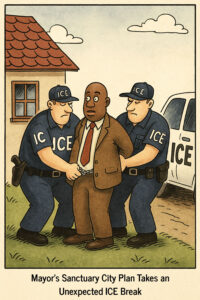 The man is hungry. That part hasn’t changed.
The man is hungry. That part hasn’t changed.
They softened the image—brushed in a little warmth, smoothed the light, brought out the curve of the spoon. The sign behind him, Volunteers of America, stands clear now, proud even. In the original photo, it was cropped out, barely legible. But someone made a choice to include it. To paint him in full.
And now here he is, again. Not just a man in a bread line during the Depression, but something closer, more intimate. Someone you could mistake for your grandfather. Or your neighbor. Or the man on the bench outside the gas station last week, coat too big, cup too empty.
We do this with the past. We retouch it. Reframe it. Soften the parts that chafe. But this image, for all its nostalgic tones, doesn’t let go of the ache. It reminds us that the hunger was real. That the charity was necessary. That the man’s dignity is not in the brushstrokes—but in the way he holds the bowl without complaint.
It also reminds us that hunger didn’t disappear when the cameras did.
In 1935, he lined up quietly at a soup kitchen. In 2025, someone’s doing the same at a food bank in your county. Same hands. Same need. Different coat.
And here we are, polishing the past like it was a lesson already learned. Pretending “again” means greatness instead of emergency all over again.
There’s a danger in mistaking warmth for truth. In imagining that if we just paint the past well enough, we won’t have to face how present it still is.
This man deserved more than a bowl and a borrowed coat. So do the ones here now.
We didn’t escape this era. We just rebranded it.
And we are not done feeding each other yet.
The Past, Reimagined Like Rockwell #15
Is This the “Again?” #9
About “Again”
Each image in this series confronts the myth behind “Make America Great Again.” By adopting Norman Rockwell’s nostalgic style but inserting America’s excluded truths, the series asks: When was it great? For whom? It’s not just a reimagining — it’s a reckoning.


